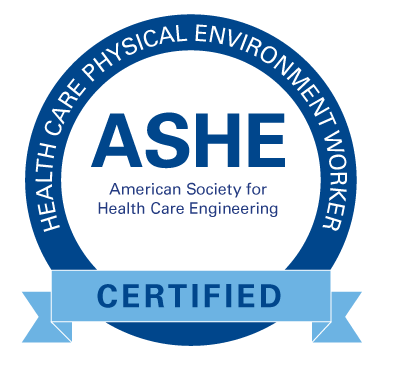
Working in Health Care: Certified Health Care Physical Environment Worker Education & Exam Review
Protect patients, staff and visitors with your awareness of the construction challenges unique to a health care site.
Save lives, reduce risk and decrease costs. Gain insights on the unique challenges for construction projects taking place in a health care setting. Review code compliance requirements, infection prevention, fire and life safety and find out details on how your team’s actions can positively or negatively impact the safety of patients, staff and visitors.
Register for an Upcoming Live Program

Host a Program
Can’t send your team off-site to get the training they need? Let us bring the educational opportunities to you! Bring ASHE’s expert faculty members to your organization.
Learn moreAbout
Analyze the unique challenges you and your crew face when working construction projects in a health care environment. Contribute to saving lives by reducing risks to patients, staff, crew and visitors. Learn how to reduce a facility’s construction costs by becoming aware of intricacies and differences of health care environment in all phases of construction projects. Receive guidance necessary for you and your crew’s successful participation in health care projects. Get ready for the next step in your career and prove your competencies by taking ASHE’s Certified Health Care Physical Environment Worker exam as a follow-up to this program*.
The Health Care Physical Environment Worker certification is a must-have for everyone who works or wants to work on a health care-related construction site.
What you will learn:
- Reduce risks to patients during construction.
- Describe the fundamentals of life safety and interim life safety measures (ILSMs).
- Prevent spread of infection and apply techniques for successful contamination.
- Review equipment and systems unique to health care facilities and gain strategies on system shutdowns.
- Respect and defend customer and patient expectations during construction projects.
- Study concepts included on health care physical environment worker certification exam.
Why should you take Working in Health Care?

Accurately assess risk and mitigating strategies during construction projects in a health care environment to ensure patient, staff and visitor safety as well as comfort.

Describe the fundamental differences between construction processes in a health care environment and other environments within each of the project phases.

Gain strategies for taking ASHE’s Certified Health Care Physical Environment Worker exam and review details of the certification’s concepts.
- Health care regulatory environment
- Construction risk assessment
- Infection control and prevention
- Risk assessment
- Mitigation recommendations
- Non-infectious environmental risks
- Life safety and fire safety
- Alternate and interim life safety measures
- Utility system shutdowns
- Project closeout and transition to occupancy
- Subcontractors
- Specialty contractors
- Anyone who works on a health care-related construction site
Live Online or In-Person 1 day
- CECs:
- 1 Day: 7 CECs
- 1/2 Day: 4 CECs
- Pricing:
- In-Person: ASHE Member: $485 | Nonmember: $605
- Live Online Training: ASHE Member: $345 | Nonmember: $435
Additional Information & Resources:
Participants will receive a copy of Working in Health Care: A Guide for Facility Business Partners, Construction Professionals, and Subcontractors.
Please note:
* The program does not include the Certified Health Care Physical Environment Worker certification exam fee nor does it register you for the exam. Participation in this review program does not guarantee a passing score on the exam. To register for the Certified Health Care Physical Environment Worker exam, please click here.
ASHE Members Save on Registration
ASHE members save on educational programs and much more! Members benefit from best-in-class tools, products, education, and training to ensure a safe environment for workers, hospital staff, visitors, and patients.


